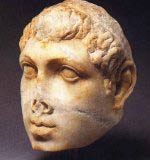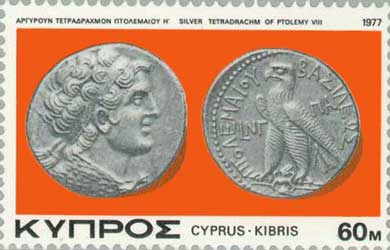.

Ptolemy VIII Euergetes Physcon
Ptolemy VIII Euergetes II (Ptolemaios VIII Euergetes II)(Greek: Πτολεμαίος Η' Ευεργέτης Β' Φύσκων) (c. 182 BC - 26 June 116 BC), nicknamed "Physcon" ("Potbelly" or "Bladder") for his obesity, was a king of the Ptolemaic dynasty in Egypt. His complicated career started in 170 BC, when Antiochus IV Epiphanes invaded Egypt and installed the young Euergetes as king.
After Antiochus left (169), Euergetes agreed to a joint rule with his older brother Ptolemy VI Philometor and Cleopatra II. This arrangement led to continuous intrigues, lasting until October 164, when Philometor went to Rome to angle for support from the Senate, who were little helpful, but Physcon's sole rule was not popular, and in May 163 the two brother agreed to a partition that left Physcon in charge of Cyrenaica.
Although the arrangement lasted until Philometor's death in 145, it did not end the sparring. Physcon convinced the Senate to back his claim on Cyprus, but Philometor ignored this, and after Physcon's attempt to conquer the island failed, in 161 the Senate sent Philometor's ambassadors home. Sometime around 156/155 Philometor tried to have Physcon assassinated, but this failed, and Physcon went to Rome, displayed the scars of wounds he received in the attempt, and despite the opposition of Cato the Elder, received the Senate's support and some resources for another attempt on Cyprus. (An inscription records that Physcon had bequeathed Cyrenaica to Rome if he died childless, an act not mentioned by any literary source.)

Silver Tetradrachm of Ptolemy VIII
The second attempt on Cyprus also failed, and Philometor captured Physcon, but spared him, offered him the hand of his daughter Cleopatra Thea, and sent him back to Cyrenaica.
When Philometor died on campaign in 145, Cleopatra II had her son proclaimed Ptolemy VII, but Physcon returned, proposed a joint rule and marriage to Cleopatra II, then had the unlucky youth assassinated during the wedding feast. He then took the throne as "Ptolemy VIII Euergetes II", the name deliberately recalling his ancestor Ptolemy III, and had himself proclaimed as pharaoh in 144.
Physcon took his revenge on the Jews and intellectuals of Alexandria who had opposed him, engaging in mass purges and expulsions that included Aristarchus and Apollodorus, leaving Alexandria a changed city.
He then seduced and married Cleopatra III without divorcing Cleopatra II, who was infuriated, and by 132 or 131, the people of Alexandria rioted and set fire to the royal palace. Physcon, Cleopatra III, and their children escaped to Cyprus, while Cleopatra II had his 12-year-old son, Ptolemy Memphitis acclaimed as king - Physcon was however able to get hold of the boy, killed him, and sent the dismembered pieces to Cleopatra.
The ensuing civil war pitted Cleopatra's Alexandria against the countryside, who supported Physcon. Cleopatra offered the throne of Egypt to Demetrius II Nicator, but he got no further than Pelusium, and by 127 Cleopatra left for Syria, leaving Alexandria to hold out for another year.
After further intrigues, Cleopatra II ended up back in Egypt in 124 BC, and about this time Physcon sent his second daughter by Cleopatra III, Cleopatra Tryphaena, to marry Antiochus VIII Philometor. A formal amnesty decree followed in 118 BC, but it was insufficient to improve government, and the Romans would soon be forced to intervene after his death in 116.
When he died he left the throne to Cleopatra III and one of her sons, whichever she preferred. If it were up to her, her younger son Alexander would reign with her. However, the Alexandrians wanted her older son Philometer Soter, governor of Cyprus, to co-reign. She reluctantly complied, with Philometer taking the name Ptolemy IX, though her younger son would rule at one point.
| Preceded by: Ptolemy VI and Cleopatra II |
Ptolemaic King of Egypt First Reign with Ptolemy VI and Cleopatra II |
Succeeded by: Ptolemy VI and Cleopatra II |
| Preceded by: Ptolemy VII and Cleopatra II |
Ptolemaic King of Egypt Second Reign with Cleopatra II and Cleopatra III |
Succeeded by: Cleopatra II |
| Preceded by: Cleopatra II |
Ptolemaic King of Egypt Third Reign with Cleopatra II and Cleopatra III |
Succeeded by: Ptolemy IX and Cleopatra III |
Portrait Head of a Ptolemaic Ruler, probably Ptolemy Memphites
Links
History of Greek and Roman Egypt
Ptolemy Euergetes II at LacusCurtius — (Chapter X of E. R Bevan's House of Ptolemy, 1923)
Print Reference
Peter Green, Alexander to Actium (University of California Press, 1990) ISBN 0-520-05611-6
| Ancient Greece
Science, Technology , Medicine , Warfare, , Biographies , Life , Cities/Places/Maps , Arts , Literature , Philosophy ,Olympics, Mythology , History , Images Medieval Greece / Byzantine Empire Science, Technology, Arts, , Warfare , Literature, Biographies, Icons, History Modern Greece Cities, Islands, Regions, Fauna/Flora ,Biographies , History , Warfare, Science/Technology, Literature, Music , Arts , Film/Actors , Sport , Fashion --- |
Retrieved from "http://en.wikipedia.org"
All text is available under the terms of the GNU Free Documentation License


